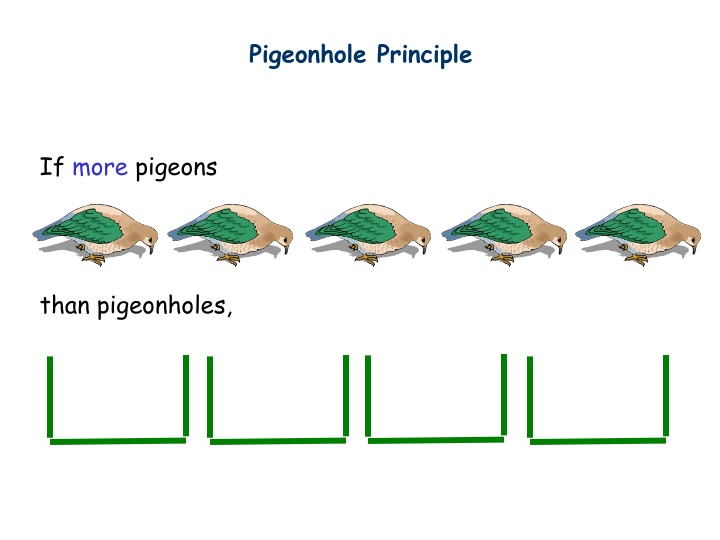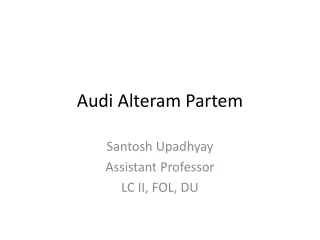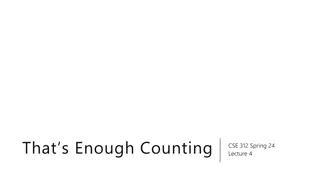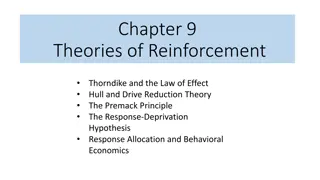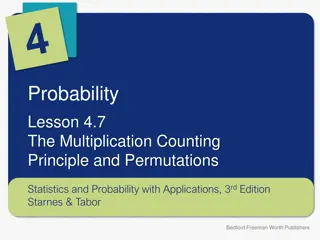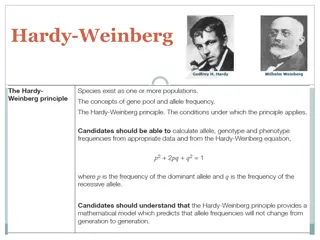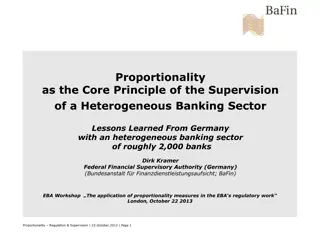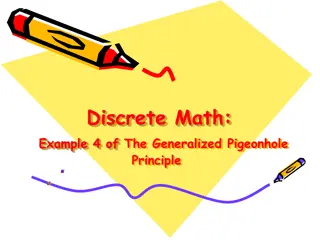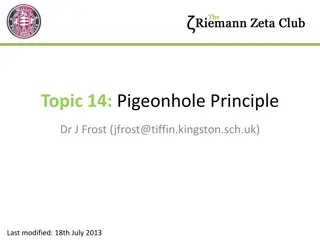Introduction to Pigeonhole Principle
The Pigeonhole Principle explains that if more pigeons are allocated to pigeonholes, then at least one hole must have multiple pigeons. This principle is also extended to the Generalized Pigeonhole Principle, showcasing that in a scenario with n pigeons and h holes, one hole will contain at least n/h pigeons. Furthermore, the "Club vs. Strangers" theorem demonstrates that any group of 6 people includes either a club of 3 individuals who all know each other, or a group of 3 strangers who haven't met. This fundamental principle underlines the concept that in any large enough structure, there will be either a structured club or a group of strangers.
Download Presentation

Please find below an Image/Link to download the presentation.
The content on the website is provided AS IS for your information and personal use only. It may not be sold, licensed, or shared on other websites without obtaining consent from the author.If you encounter any issues during the download, it is possible that the publisher has removed the file from their server.
You are allowed to download the files provided on this website for personal or commercial use, subject to the condition that they are used lawfully. All files are the property of their respective owners.
The content on the website is provided AS IS for your information and personal use only. It may not be sold, licensed, or shared on other websites without obtaining consent from the author.
E N D
Presentation Transcript
Pigeonhole Principle If more pigeons than pigeonholes,
Pigeonhole Principle then some hole must have at least two pigeons! Pigeonhole principle A function from a larger set to a smaller set cannot be injective. (There must be at least two elements in the domain that have the same image in the codomain.)
Generalized Pigeonhole Principle Generalized Pigeonhole Principle If n pigeons and h holes, then some hole has at least n h pigeons. Cannot have < 3 cards in every hole.
Club vs Strangers Let s agree that given any two people, either they have met or not. If every people in a group has met, then we ll call the group a club. If every people in a group has not met, then we ll call a group of strangers. Theorem: Every collection of 6 people includes a club of 3 people, or a group of 3 strangers. Let x be one of the six people. By the (generalized) pigeonhole principle, we have the following claim. Claim: Among the remaining 5 people, either 3 of them have met x, or 3 of them have not met x.
Club vs Strangers Theorem: Every collection of 6 people includes a club of 3 people, or a group of 3 strangers. Claim: Among the remaining 5 people, either 3 of them have met x, or 3 of them have not met x. Case 1: 3 people have met x Case 1.1: No pair among those people met each other. Then there is a group of 3 strangers. OK! OK! Case 1.2: Some pair among those people have met each other. Then that pair, together with x, form a club of 3 people.
Club vs Strangers Theorem: Every collection of 6 people includes a club of 3 people, or a group of 3 strangers. Claim: Among the remaining 5 people, either 3 of them have met x, or 3 of them have not met x. Case 2: 3 people have not met x Case 2.1: Every pair among those people met each other. Then there is a club of 3 people. OK! OK! Case 2.2: Some pair among those people have not met each other. Then that pair, together with x, form a group of 3 strangers.
Club vs Strangers Theorem: Every collection of 6 people includes a club of 3 people, or a group of 3 strangers. Theorem: For every k, if there are enough people, then either there exists a club of k people, or a group of k strangers. A large enough structure cannot be totally disorder.
More applications 3 Among n+1 positive integers not exceeding 2n there must be an integer that divides one of the other integers. Let 1 ?1< ?2< < ??+1 2? be the ? + 1 integers. No loss of generality to assume they are distinct as else the stmt is trivially true. Let ??= ??/2??be odd. Then 1 ?1,?2, ,??+1 2? 1 are ? + 1 odd integers. Since there are only ? odd integers between 1 and 2? 1, by PHP for some ?,?,??= ??. Let ??< ??. Then ??< ??and so ??= ??2??divides ??= ??2??
More applications 4 Every sequence of ?2+ 1 distinct numbers contains a subsequence of length n+1 that is strictly increasing or strictly decreasing e.g. 8, 11, 9, 1, 4, 6, 12, 10, 5, 7 contains the increasing subsequence 1,4,6,10 of length 4. Let ?1,?2,?3, ,??2+1be the sequence. Let ?(?) be the length of the longest increasing subsequence starting from ??. Similarly, ?(?) is the length of the longest decreasing subsequence starting from ??. In the above example: ?(3) = 2,?(3) = 3,?(5) = 3,?(5) = 1
More applications 4 (contd.) ?1,?2,?3, ,??2+1is the sequence. ?(?): length of the longest increasing subsequence starting from ??. ?(?): length of the longest decreasing subsequence starting from ??. If for some ?, ?(?) or ?(?) exceeds ? then we are done (there is an inc./dec. subsequence of length ? + 1). For contradiction, assume ?,1 ? ? ,? ? ?. Consider the ?2+ 1 tuples ? 1 ,? 1 , ? 2 ,? 2 , , ? ?2+ 1 ,? ?2+ 1 . Since these takes ?2different values, by PHP ?,?: ? ? ,? ? = ? ? ,? ? . No loss of generality to assume that ? < ?.
More applications 4 (contd.) ?1,?2, ,??, ,??, ,??2+1is the sequence. Longest increasing sequence starting from ??= Longest increasing sequence starting from ??= ?. Longest decreasing sequence starting from ??= Longest decreasing sequence starting from ??= ?. Two possibilities: 1. ??< ??: Then we have an increasing subsequence of length ? + 1 starting from ?? a contradiction. 2. ??> ??: Then we have a decreasing subsequence of length ? + 1 starting from ?? a contradiction. This implies tat our assumption that there is no increasing or decreasing subsequence of length more than ? is incorrect.
The Quotient-Remainder Theorem For b > 0 and any a, there are unique numbers q ::= quotient(a,b), r ::= remainder(a,b), such that a = qb + r and 0 r < b. We also say q = a div b and r = a mod b. When b=2, this says that for any a, there is a unique q such that a=2q or a=2q+1. When b=3, this says that for any a, there is a unique q such that a=3q or a=3q+1 or a=3q+2.
The Quotient-Remainder Theorem For b > 0 and any a, there are unique numbers q ::= quotient(a,b), r ::= remainder(a,b), such that a = qb + r and 0 r < b. Given any b, we can divide the integers into many blocks of b numbers. For any a, there is a unique position for a in this line. q = the block where a is in r = the offset in this block a (k+1)b kb 2b b -b 0 Clearly, given a and b, q and r are uniquely defined.
This Lecture Quotient remainder theorem Greatest common divisor & Euclidean algorithm Linear combination and GCD, extended Euclidean algorithm Prime factorization and other applications
Common Divisors c is a common divisor of a and b means c|a and c|b. gcd(a,b) ::= the greatest common divisor of a and b. Say a=8, b=10, then 1,2 are common divisors, and gcd(8,10)=2. Say a=10, b=30, then 1,2,5,10 are common divisors, and gcd(10,30)=10. Say a=3, b=11, then the only common divisor is 1, and gcd(3,11)=1. Claim. If p is prime, and p does not divide a, then gcd(p,a) = 1.
Greatest Common Divisors Given a and b, how to compute gcd(a,b)? Can try every number, but can we do it more efficiently? Let s say a>b. 1. If a=kb, then gcd(a,b)=b, and we are done. 2. Otherwise, by the Division Theorem, a = qb + r for r>0.
Greatest Common Divisors Let s say a>b. 1. If a=kb, then gcd(a,b)=b, and we are done. 2. Otherwise, by the Division Theorem, a = qb + r for r>0. gcd(8,4) = 4 gcd(12,8) = 4 a=12, b=8 => 12 = 8 + 4 gcd(9,3) = 3 a=21, b=9 => 21 = 2x9 + 3 gcd(21,9) = 3 gcd(99,27) = 9 a=99, b=27 => 99 = 3x27 + 18 gcd(27,18) = 9 Euclid: gcd(a,b) = gcd(b,r)!
Euclids GCD Algorithm a = qb + r Euclid: gcd(a,b) = gcd(b,r) gcd(a,b) if b = 0, then answer = a. else write a = qb + r answer = gcd(b,r)
Example 1 gcd(a,b) if b = 0, then answer = a. else write a = qb + r answer = gcd(b,r) GCD(102, 70) 102 = 70 + 32 = GCD(70, 32) 70 = 2x32 + 6 = GCD(32, 6) 32 = 5x6 + 2 = GCD(6, 2) 6 = 3x2 + 0 = GCD(2, 0) Return value: 2.
Example 2 gcd(a,b) if b = 0, then answer = a. else write a = qb + r answer = gcd(b,r) GCD(252, 189) 252 = 1x189 + 63 = GCD(189, 63) 189 = 3x63 + 0 = GCD(63, 0) Return value: 63.
Example 3 gcd(a,b) if b = 0, then answer = a. else write a = qb + r answer = gcd(b,r) GCD(662, 414) 662 = 1x414 + 248 = GCD(414, 248) 414 = 1x248 + 166 = GCD(248, 166) 248 = 1x166 + 82 = GCD(166, 82) 166 = 2x82 + 2 = GCD(82, 2) 82 = 41x2 + 0 = GCD(2, 0) Return value: 2.
Correctness of Euclids GCD Algorithm a = qb + r Euclid: gcd(a,b) = gcd(b,r) When r = 0: Then gcd(b, r) = gcd(b, 0) = b since every number divides 0. But a = qb so gcd(a, b) = b = gcd(b, r), and we are done.
Correctness of Euclids GCD Algorithm a = qb + r Euclid: gcd(a,b) = gcd(b,r) When r > 0: Let d be a common divisor of b, r b = k1d and r = k2d for some k1, k2. a = qb + r = qk1d + k2d = (qk1+ k2)d => d is a divisor of a Let d be a common divisor of a, b a = k3d and b = k1d for some k1, k3. r = a qb = k3d qk1d = (k3 qk1)d => d is a divisor of r So d is a common factor of a, b iff d is a common factor of b, r d = gcd(a, b) iff d = gcd(b, r)
How fast is Euclids GCD Algorithm? Naive algorithm: try every number, Then the running time is about 2b iterations. Euclid s algorithm: In two iterations, the b is decreased by half. (why?) Then the running time is about 2log(b) iterations. Exponentially faster!!
This Lecture Quotient remainder theorem Greatest common divisor & Euclidean algorithm Linear combination and GCD, extended Euclidean algorithm Prime factorization and other applications
Linear Combination vs Common Divisor Greatest common divisor d is a common divisor of a and b if d|a and d|b gcd(a,b) = greatest common divisor of a and b Smallest positive integer linear combination d is an integer linear combination of a and b if d=sa+tb for integers s,t. spc(a,b) = smallest positive integer linear combination of a and b Theorem: gcd(a,b) = spc(a,b)
Linear Combination vs Common Divisor Theorem: gcd(a,b) = spc(a,b) For example, the greatest common divisor of 52 and 44 is 4. And 4 is a linear combination of 52 and 44: 6 52 + ( 7) 44 = 4 Furthermore, no linear combination of 52 and 44 is equal to a smaller positive integer. To prove the theorem, we will prove: gcd(a,b) | spc(a,b) gcd(a,b) <= spc(a,b) spc(a,b) is a common divisor of a and b spc(a,b) <= gcd(a,b)
GCD <= SPC 3. If d | a and d | b, then d | sa + tb for all s and t. Proof of (3) d | a => a = dk1 d | b => b = dk2 sa + tb = sdk1+ tdk2= d(sk1+ tk2) => d|(sa+tb) Let d = gcd(a,b). By definition, d | a and d | b. GCD | SPC Let f = spc(a,b) = sa+tb By (3), d | f. This implies d <= f. That is gcd(a,b) <= spc(a,b).
SPC <= GCD We will prove that spc(a,b) is actually a common divisor of a and b. First, show that spc(a,b) | a. 1. Suppose, by way of contradiction, that spc(a,b) does not divide a. 2. Then, by the Division Theorem, 3. a = q x spc(a,b) + r and spc(a,b) > r > 0 4. Let spc(a,b) = sa + tb. 5. So r = a q x spc(a,b) = a q x (sa + tb) = (1-qs)a + qtb. 6. Thus r is an integer linear combination of a and b, and spc(a,b) > r. 7. This contradicts the definition of spc(a,b), and so r must be zero. Similarly, spa(a,b) | b. So, spc(a,b) is a common divisor of a and b, thus by definition spc(a,b) <= gcd(a,b).
Extended GCD Algorithm How can we write gcd(a,b) as an integer linear combination? This can be done by extending the Euclidean s algorithm. Example: a = 259, b=70 259 = 3 70 + 49 49 = a 3b 21 = 70 - 49 70 = 1 49 + 21 21 = b (a-3b) = -a+4b 49 = 2 21 + 7 7 = 49 - 2 21 7 = (a-3b) 2(-a+4b) = 3a 11b 21 = 7 3 + 0 done, gcd = 7
Extended GCD Algorithm Example: a = 899, b=493 899 = 1 493 + 406 so 406 = a - b 493 = 1 406 + 87 so 87 = 493 406 = b (a-b) = -a + 2b 406 = 4 87 + 58 so 58 = 406 - 4 87 = (a-b) 4(-a+2b) = 5a - 9b 87 = 1 58 + 29 so 29 = 87 1 58 = (-a+2b) - (5a-9b) = -6a + 11b 58 = 2 29 + 0 done, gcd = 29
This Lecture Quotient remainder theorem Greatest common divisor & Euclidean algorithm Linear combination and GCD, extended Euclidean algorithm Prime factorization and other applications
Application of the Theorem Theorem: gcd(a,b) = spc(a,b) Why is this theorem useful? (1) we can now write down gcd(a,b) as some concrete equation, (i.e. gcd(a,b) = sa+tb for some integers s and t), and this allows us to reason about gcd(a,b) much easier. (2) If we can find integers s and t so that sa+tb=c, then we can conclude that gcd(a,b) <= c. In particular, if c=1, then we can conclude that gcd(a,b)=1.
Prime Divisibility Theorem: gcd(a,b) = spc(a,b) Lemma: p prime and p|a b implies p|a or p|b. pf: say p does not divide a. so gcd(p,a)=1. So by the Theorem, there exist s and t such that sa + tp = 1 (sa)b + (tp)b = b Hence p|b p|p p|ab Cor : If p is prime, and p| a1 a2 amthen p|ai for some i.
Fundamental Theorem of Arithmetic Every integer, n>1, has a unique factorization into primes: p0 p1 pk p0p1 pk = n Example: 61394323221 = 3 3 3 7 11 11 37 37 37 53
Unique Factorization Theorem: There is a unique factorization. proof: suppose, by contradiction, that there are numbers with two different factorization. By the well-ordering principle, we choose the smallest such n >1: n = p1 p2 pk = q1 q2 qm Since n is smallest, we must have that pi qj all i,j (Otherwise, we can obtain a smaller counterexample.) contradiction! Since p1|n = q1 q2 qm, so by Cor., p1|qi for some i. Since both p1 = qiare prime numbers, we must have p1 = qi.
Application of the Theorem Theorem: gcd(a,b) = spc(a,b) Lemma. If gcd(a,b)=1 and gcd(a,c)=1, then gcd(a,bc)=1. By the Theorem, there exist s,t,u,v such that sa + tb = 1 ua + vc = 1 Multiplying, we have (sa + tb)(ua + vc) = 1 saua + savc + tbua + tbvc = 1 (sau + svc + tbu)a + (tv)bc = 1 By the Theorem, since spc(a,bc)=1, we have gcd(a,bc)=1
Die Hard Simon says: On the fountain, there should be 2 jugs, do you see them? A 5-gallon and a 3-gallon. Fill one of the jugs with exactly 4 gallons of water and place it on the scale and the timer will stop. You must be precise; one ounce more or less will result in detonation. If you're still alive in 5 minutes, we'll speak.
Die Hard Start with empty jugs: (0,0) Fill the big jug: (0,5) 3 Gallon Jug 5 Gallon Jug
Die Hard Pour from big to little: (3,2) 3 Gallon Jug 5 Gallon Jug
Die Hard Empty the little: (0,2) 3 Gallon Jug 5 Gallon Jug
Die Hard Pour from big to little: (2,0) 3 Gallon Jug 5 Gallon Jug
Die Hard Fill the big jug: (2,5) 3 Gallon Jug 5 Gallon Jug
Die Hard Pour from big to little: (3,4) 3 Gallon Jug 5 Gallon Jug Done!!
Die Hard What if you have a 9 gallon jug instead? 3 Gallon Jug 5 Gallon Jug 9 Gallon Jug Can you do it? Can you prove it?
Die Hard Supplies: 3 Gallon Jug 9 Gallon Jug Water
Invariant Method Invariant: the number of gallons in each jug is a multiple of 3. i.e., 3|b and 3|l (3 divides b and 3 divides l) Corollary: it is impossible to have exactly 4 gallons in one jug. Bruce Dies!
Generalized Die Hard Can Bruce form 3 gallons using 21 and 26-gallon jugs? This question is not so easy to answer without number theory.
General Solution for Die Hard Invariant in Die Hard Transition: Suppose that we have water jugs with capacities B and L. Then the amount of water in each jug is always an integer linear combination of B and L. Theorem: gcd(a,b) = spc(a,b) Corollary: Every linear combination of a and b is a multiple of gcd(a, b). Corollary: The amount of water in each jug is a multiple of gcd(a,b).
General Solution for Die Hard Corollary: The amount of water in each jug is a multiple of gcd(a,b). Given jug of 3 and jug of 9, is it possible to have exactly 4 gallons in one jug? NO, because gcd(3,9)=3, and 4 is not a multiple of 3. Given jug of 21 and jug of 26, is it possible to have exactly 3 gallons in one jug? gcd(21,26)=1, and 3 is a multiple of 1, so this possibility has not been ruled out yet. Theorem. Given water jugs of capacity a and b, it is possible to have exactly k gallons in one jug if and only if k is a multiple of gcd(a,b).
